|
Michael McFadyen's Scuba Diving - Osborn Shoal
Although some Sydney divers will tell you that the best dive sites are to be found by diving out of Sydney Harbour or from the northern beaches, divers who have dived from Port Hacking will agree that the ocean off Cronulla and Royal National Park contains far better dive sites. Among the abundant excellent dive locations off this section of the coast is Osborn Shoal.
Located directly off Cronulla Beach, Osborn Shoal (this is the name preferred by the NSW Geographical Names Board) is one part of the reef that can be found intermittently from Kurnell to Bundeena across Bate Bay. Like Merries Reef further to the north, the top of the shoals is generally flat and covered in kelp, although some parts are covered with sponges. Once you drop off the top, however, things change. On the eastern, northern and southern sides a sharp drop off takes place with the depth going from 12 to 20 or more metres in some spots. These are the best sections.
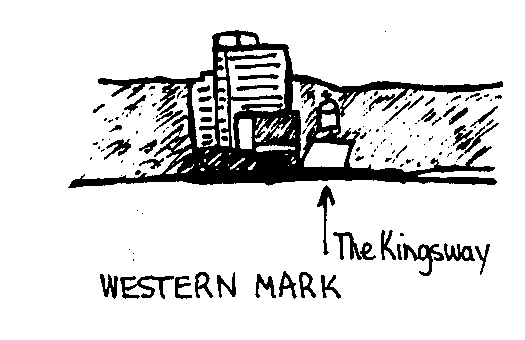 | 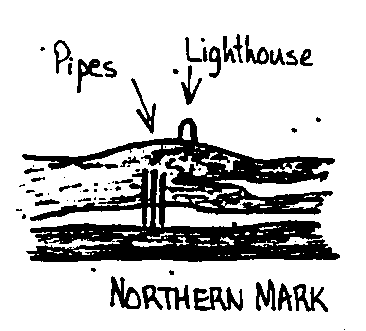 |
Western Mark
Click to enlarge
Note largest building no longer exists | Northern Mark
Click to enlarge |
The marks for finding the reef (shown at left) are described as follows. The western mark is found by lining up on the middle of The Kingsway at Cronulla. The northern mark is found by lining up the sewerage outlet breather pipes at Potter Point with the dune ridge to the immediate left of Cape Baily Lighthouse. GPS Marks of 34° 03.4883' S 151° 11.2691' E (using WGS84 as the map datum). If you use another datum you may be about 220 metres off the wreck. See my GPS Page for more details and how to convert readings.
In a north-easterly breeze, run in over the shoals from a southerly direction. As soon as the depth sounder shows a drop in depth from about 12 metres to 18 metres, drop anchor. This should place you over the northern-most part of the reef adjacent to the cave. In a southerly breeze, work into the wind and drop anchor on the reef top. If you do this you should be aware that it is often very difficult to get a good anchor hold on the reef itself.
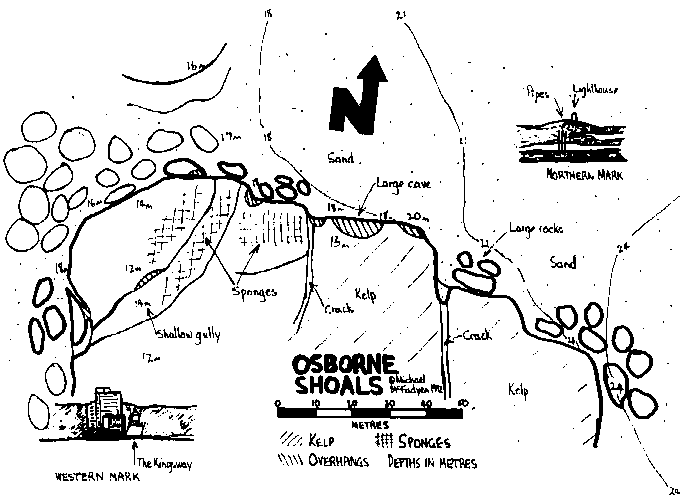 |
Map of Osborn Shoal
Click to enlarge |
After descending to the anchor, if you are not already on the reef edge, swim to the north. The most interesting dive is normally to your right as you reach the sand which is about 18 metres deep. Keeping the shoals on your right-hand, swim to the east. If you have anchored on target, you will see a large cave after only a few metres. If you are too far to the west you will go over some large rocks located just off the reef. Just past here is the cave. Swim into the cave and examine the roof, sides and floor and you will notice some very interesting gorgonias, jewel anemones, sponges and sea squirts. This is also known by some as Meditation Cave. This name came from a member of the St George Scuba Club who used to enter this cave and just relax and meditate whenever he dived here. You can see why he might have done this when you look at the beautiful colours.
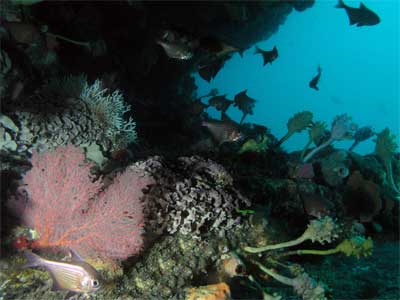 |
| Looking to the north west from inside Meditation Cave |
When you come back out onto the sand, it is about 20 to 21 metres deep. Continue to the east past a small overhang on the corner as the reef turns to the south. Even more marine life can be found on the walls of the reef in this area. Ahead there is a small "inlet" and a crack that leads over the reef to the south. The sand here is home to the very strange looking serpent eels. If you do not disturb the area, you might be able to see their heads sticking up out of the sand. To the left there are some large boulders and then a sandy patch. Past here there are more rocks. There are some overhangs here that have cuttlefish and octopus living in them. I have even seen a huge octopus guarding her eggs.
Most divers will have to turn around in this area as they will have used half their air supply. If you have air to spare, and your bottom time is not over 20 minutes, you can continue along the reef edge for a little longer. The rocks run out about 20 to 30 metres from the main wall here. The reef goes further to the east but then it turns to the south before going back to the west. The depth will increase to 24 metres. We have done this as a drift dive and continued past her to the south. The depth increases and eventually you have to surface due to running out of bottom time.
An alternative to continuing along the reef from the place where the serpent eels live is to follow the crack to the south up over the reef which here is about 18 metres deep.
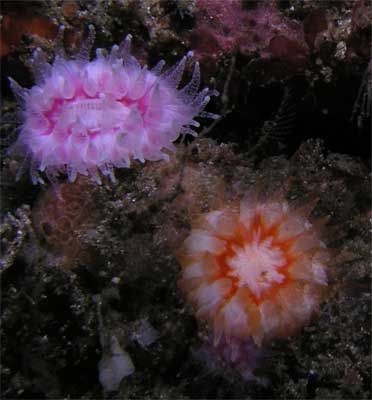 |
| Pink and orange jewel anemones |
No matter which route you chose to take, you will soon have to turn around and return back to the boat's anchor. It is a fairly simple matter of keeping the reef on your left all the way back. When you return to the area of the anchor, you will probably have some time to spare and be able to feed the blue gropers and wrasse that frequent the reef top. Due to the depth of this dive, it is advisable to spend a few minutes on a safety stop.
On subsequent dives here, and if you are an experienced diver, you can explore further to the west before returning back to the boat. This should only be attempted if you are very good on your air consumption. An alternative to going so far is to turn around earlier and dive back past the anchor to the west. The wall breaks up a bit and it is a bit shallower but it is still a very good dive. After about 40 metres the reef turns to the south and it gets a bit deeper (max 16 metres). You will see a crack running into the reef but it is too narrow to swim right through. About 10 metres further on the crack returns back to the wall and you can swim along it for a short distance before you meet the narrow part of the crack. From here you can follow the shallow gully back to the north-east over the reef top. This will return you to near the anchor. You will see a very nice sponge garden on the reef top just before the reef's edge.
If you decide to dive to the west and keep going past the spot mentioned above, there is a nice wall on your left with a lot of broken reef to your right. There is even a bit of a wall about 30 metres off to your right in some spots. The only time I have gone this far, the fishlife was absolutely amazing! There were huge schools of yellowtail, ladder-finned pomfret and seapike all over the wall and reef. As well, there were lots of black reef leatherjackets, six-spined leatherjackets, luderick, bream and other reef species. We even had a school of about 50 kingfish circle us for about five minutes.
Sealife that you will almost certainly see at Osborn Shoal includes many different kinds of nudibranchs, with colours varying from white to pink to blue and other beautiful colours. Fish to be found here include blue groper (very friendly), red morwong, cuttlefish, mado, stripey, common bullseye, crimson-banded wrasse, maori wrasse, silver sweep, sergeant baker, old wife, striped seapike, white ear, black reef leatherjacket, yellow-striped leatherjacket, Port Jackson sharks, one-spot puller, ladder-finned pomfret, blue-striped goatfish, yellowtail, pufferfish, eastern blue devil (very beautiful) as well as the previously mentioned serpent eels. Large dusky flatheads and common stingarees can be seen on the sand and you will almost certainly see common sea-dragons near the rocks on the eastern side and west of the cave. I have even seen tiny firefish near the cave.
This dive can be done as a drift dive by starting at the entry point described above and drifting to the south along the eastern side of the reef. It is a very good option and well worth doing. I have not drifted to the west and then south, but I suspect it would also be a very good dive.
The visibility here is usually quite good, with 9 to 12 metres being average. In March 2001 I had in excess of 25 metres and in August 2005 over 15 metres.
| 
 v6.00.307 © 2003-2005
v6.00.307 © 2003-2005